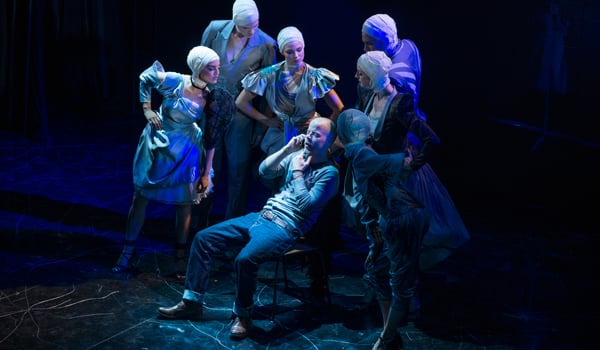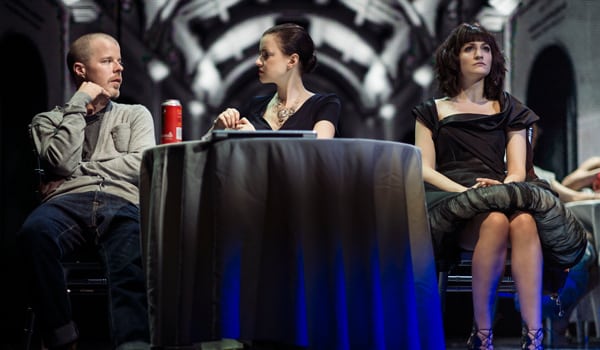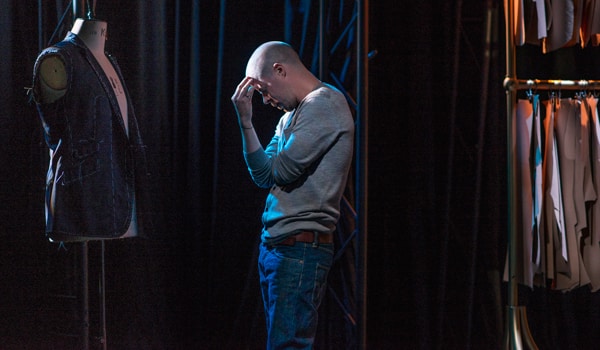
McQueen
Theatre Royal Haymarket
27/08/15
BUY TICKETS
‘Love looks not with the eyes but with the mind.’
Shakespeare, A Midsummer Night’s Dream
McQueen opened this year at the St James Theatre and now transfers for a limited West End run to the Theatre Royal Haymarket after some cast changes and a degree of rewriting by playwright James Phillips. It is directed by John Caird, with choreography by Christopher Marney, and stars Stephen Wight as McQueen himself, whom we see as we take our seats, pacing the stage, already in role, unbiddable and unpredictable, twisting and contemplating the belt with which he may be about to end his life….
Alexander/Lee McQueen – his life, work, associates, tragic death and legacy – provides almost too rich a trove of material for dramatic treatment. In the recent extraordinary V&A retrospective, Savage Beauty, there was one remarkable frock coat of gilded feathers, high in the collar and tight at the waist, which reappears in modified form to play a role here in the second half as a symbol of how clothes can transform the wearer. To me, though, it was also a symbol of the complexity of this subject – ostensibly one of glittering surfaces and a surfeit of glamour – akin to the Regency bling of the Haymarket where we were all assembled on Press Night; but where the heart of the matter is in evoking the psyche of a man who according to those who worked with him fizzed with as many ideas and moods a day as there are feathers in that glorious coat.

With a life and death lived out in the full glare of publicity, where there are many people who new McQueen well, and most of us who now think we know something, the business of capturing the essence of the man’s vertiginous genius and manifold contradictions and giving it fresh dramatic life is a very hard ask. We know from his City Stories, reviewed here a few months ago, that James Phillips has an innovative mind’s eye for structure, a poetically suggestive way with dialogue, a keen appreciation of the interpenetration of words and music, and a proven gift for writing about London life, all of them necessary parts of the equation. Would he rise to this new challenge?
What we are given is a fairy story that elaborates the storyline of one of McQueen’s own elaborate, semi-operatic, catwalk scenarios. Dahlia (Carly Bawden) after observing McQueen from a tree in his garden, enters his house in order to make off with a dress, and meets the designer himself amidst his mannequins in the basement. He rings long-term collaborator Philip Treacy for advice on calling the police, but stubborn Dahlia charms him into a bargain: she will disappear at the end of the night if in return he transforms her into a princess by making her a dress and showing her different visions of London. He agrees in the hope that he will also find inspiration to meet the deadline for his next collection.
What follows is a sequence of phantasmagorical scenes which explore key relationships, experiences and issues in McQueen’s life – his training in Savile Row, his friendship with Isabella Blow (Tracy-Ann Oberman), a V&A party where journalist Arabella (Laura Rees) challenges the authenticity of his talent, and his close connection with his mother and Stratford roots. In most of them Dahlia is either an observer, an ornery participant or an expression of McQueen’s own ‘feminine’ side; but by the end it is clear she always wanted more than simply a dress from this encounter. Each scene is linked to the next with a choreographed episode in which nine dancers channel the themes through the visual imagery of one of his classic openings, using the same music that was played on those occasions. We return finally to the basement where we began as night ends, Dahlia departs and Lee has his concept for his next collection…..

This play is therefore not a straight bio-documentary, which is surely a correct decision; for it would be hard to avoid clunky and undramatic factual exposition on the one hand, or crude tabloid sensationalism on the other. Phillips is much more interested in capturing the mercurial many-sidedness of McQueen’s anguished yet tough-minded and humorous personality and in exploring the nature and sources of his creativity. He achieves both of these goals, the first aided through an exceptionally detailed, mesmeric performance by Wight, which is so much more than an impersonation. And the second comes off because he succeeds, much of the time, in finding a dramatic formula for both describing McQueen’s gifts and showing them at work.
One example of this comes in the form of a number of remarkable monologues scattered through the play in which the designer analyses his forensic and aesthetic intentions. This could easily not work. It could become too didactic or just too tricksy – ‘Six Costumes in Search of a Couturier’ etc.. That it is not is a tribute to the actor and to the way the writing forces you to look and imagine with a designer’s eye. It’s rather like the Conan Doyle story in which Holmes tells you everything about a person’s life from a few details of their clothing, and sees right through them. The brilliant but also destabilizing, unforgiving and isolating quality of that degree of perception is made palpable; so much so that there was an extra intense hush of inward concentration right across the fashionable and fashionista audience. They knew they too were under the microscope at that point ….We got a palpable dramatic sense of why McQueen was both such a beguiling and alarming man to be around.
Another instance of showing and telling working well in tandem came in the scene set in Anderson & Sheppard, where McQueen trained. His cutting of the dress made for Dahlia on her person demonstrated in the most direct way possible the traditional tailoring skills he learned there, and the dialogue with his mentor Mr Hitchcock (Michael Bertenshaw) revealed the balance between a sense of history and subversion that he always tried to maintain in his work: if you are going to be an iconoclast you have to be a traditionalist first!

Not everything succeeds. The scene with Isabella Blow is an elaborately Baroque duet between two natural divas, but lacks dramatic bite as a result, more especially when there is a good deal of uncharacteristically clumsy filling in of ‘facts you need to know first.’ If this were an opera you could get away with this back-story packaging, but not here. More seriously there is a fuzziness around the character of Dahlia that is not always helpful, and sometimes undermines dramatic coherence. What exactly is Dahlia’s contribution? As muse, mere theatrical device, or projection of part of Lee’s own personality? This matters particularly in the second half of the show where she is much more prominent and it is not enough to leave this issue floating unresolved. We do not care enough about her as a character in her own right at this stage for the dramatic structure to take the weight, and this is only partially redeemed by the memorable summing-up that Lee gets to deliver in the final minutes.
I am not sure that inserting an interval for the West End has actually helped the play. It would work better in continuous sequence without placing equal weight on the thinner material in what is now the second half, while preserving the delicate fantasy ambience unbroken.
The production values are excellent. The direction is fluent and with a painterly eye for visual tableaus as much as kinetic energy. The choreography is outstandingly varied and imaginative: the dancers clear the set, pose as mannequins, and in fact act more as a non-vocal chorus offering a visual commentary on and integral with the action. The wardrobe team has performed the tricky task of referencing the designer’s work while not slavishly copying it, and video projections give a vivid sense of London locations when needed.

Wight’s embodiment of McQueen is peerless. The mannerisms, the combination of brashness and vulnerability in speech and movement, the extremes of sensitivity and vulgarity, consideration and ruthless selfishness, were all in place, together with a self-awareness about depression, fear of death and the alarming nature of his own talent that was finely observed. Bawden does very well with Dahlia, making sure she stands up to Wight’s character when needed while not losing her goofy charm: but the role itself is really still unfinished. Oberman and Rees take their opportunities to the full, and Bertenshaw’s understated gentleman’s tailor provides a welcome point of repose and carefully contrasted restraint.
The evening is continuously thought-provoking, visually spectacular, and highly ingenious in integrating design, music, dance and characterization to give as detailed a portrait of the sources of McQueen’s creativity as we are likely to get. Parts are both unexpectedly funny and genuinely moving too. Putting the creative process of an artist itself on stage is a tricky business – in recent times perhaps Sunday in the Park with George is the only fully successful example. Short of a musical or operatic treatment of McQueen’s life – something that might well still be worth doing given the scope the subject offers to all the theatrical arts – this play stands as a bold and broadly successful artistic portrait.
The play triumphantly recovers and re-asserts McQueen’s credo that design is at its best an act of love of the person – a summing up of who that man or woman was, is and may become – and therefore lies, paradoxically, in the mind as much as purely in the visual sense. It was for this reason that Alexander McQueen chose the Shakespeare line that heads this review to wear as a tattoo – a blazon for his time, and – surely – for all our times.
